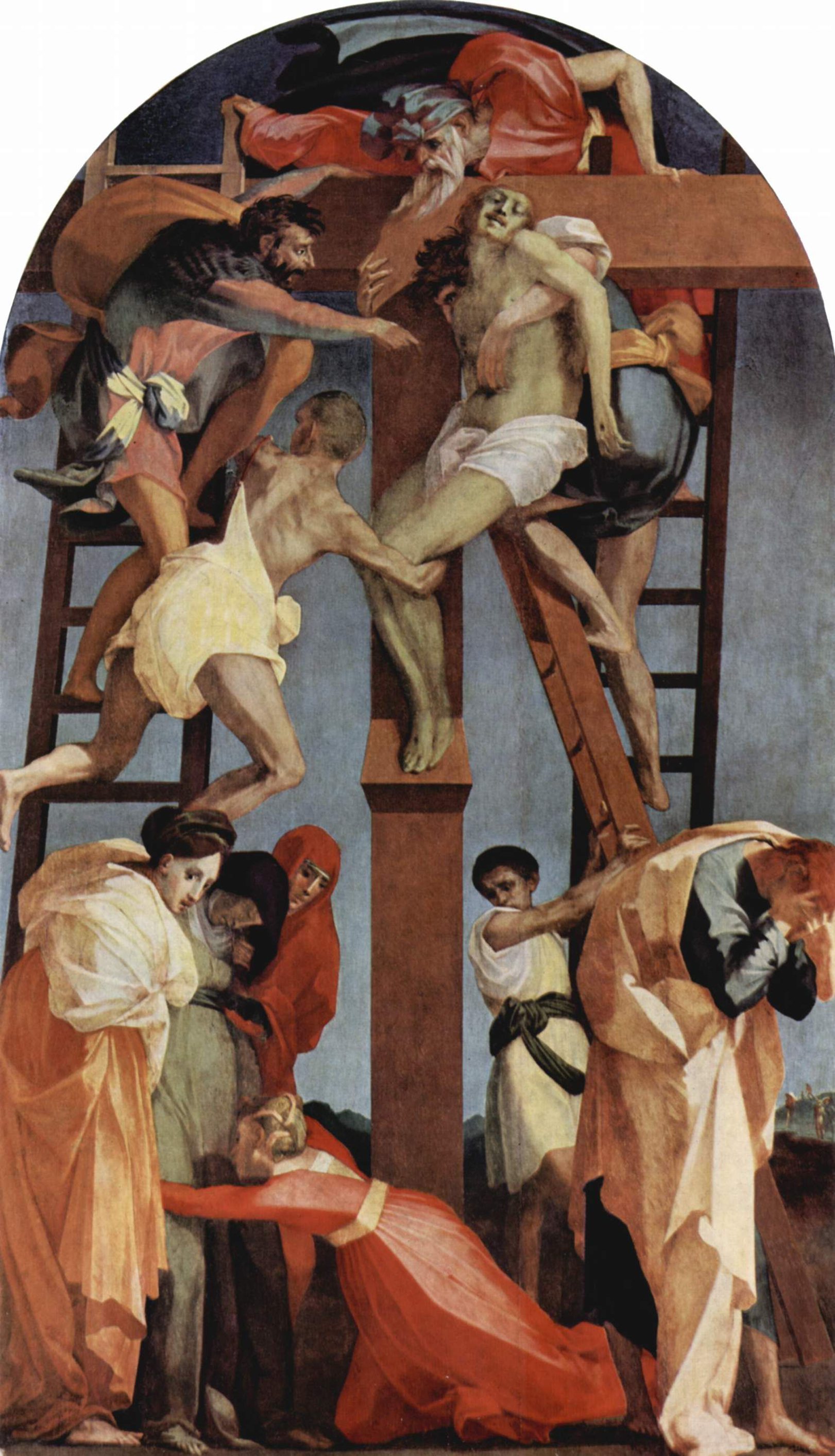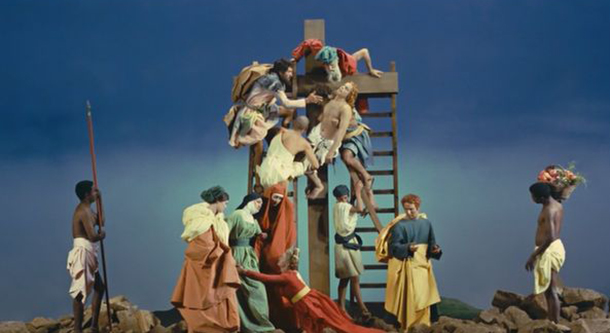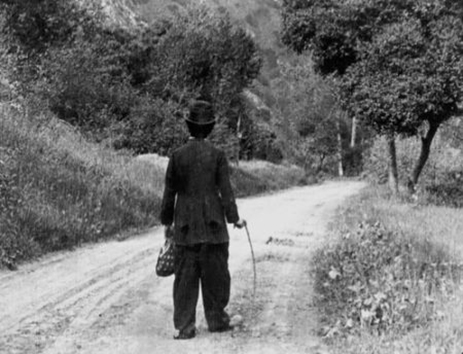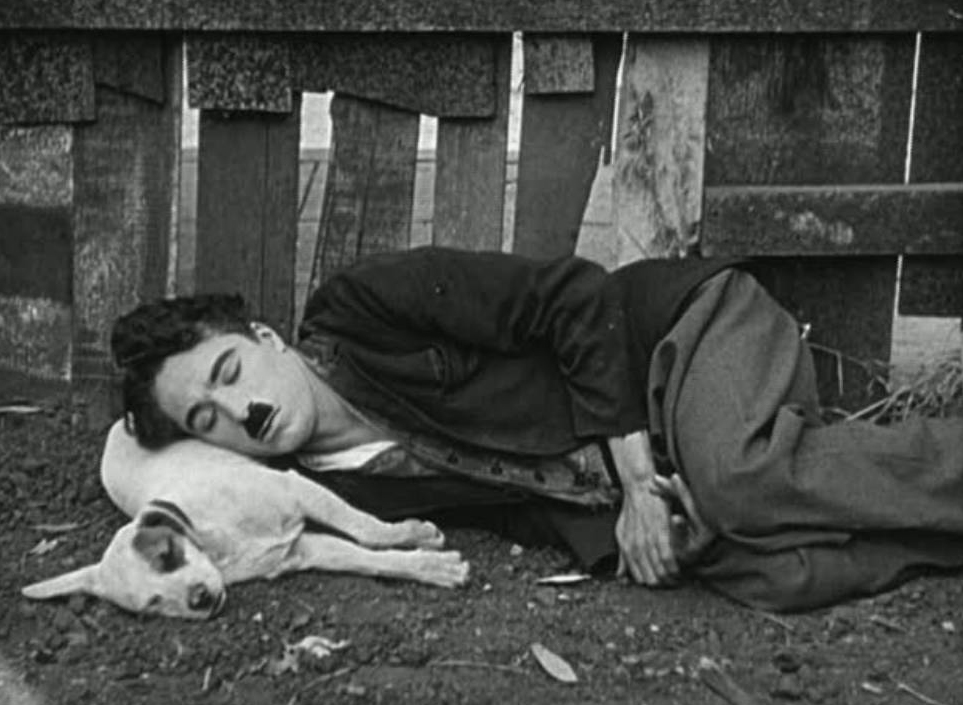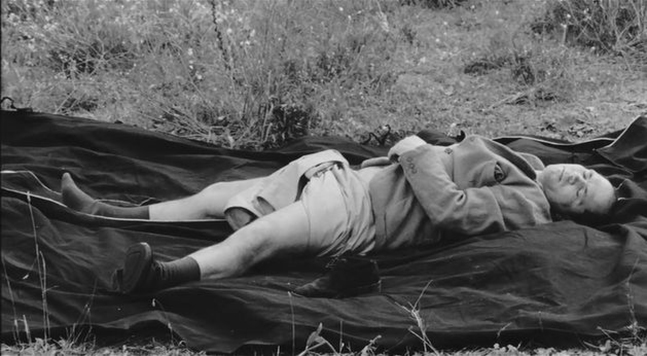Dark Fragments: Contrasting Corporealities in Pasolini’s La ricotta
Jill Murphy
Introduction
The corporeal—the quality and materiality of the body—is a driving force that accompanies more formal considerations throughout Pier Paolo Pasolini’s cinematographic work. From the physicalities of Accattone (1961) and Mamma Roma (1962), through the celebration of the carnivalesque and the sexual in the “Trilogia della vita” films, to the corporeal transgressions of Pigsty (Porcile, 1969) and Salò, or the 120 days of Sodom (Salò, o le 120 giornate di Sodoma, 1975), Pasolini is consistently guided by a deep-rooted sense of the physical in a range of guises. In his short film La ricotta (1963), filmed just before The Gospel According to St. Matthew (Il Vangelo secondo Matteo, 1964), the corporeal is central to the narrative, but is complex and fragmented, operating in distinct modes. [1] The film tells the meta-cinematic tragicomic tale of Stracci (Mario Cipriani), an extra working on a film of the life of Christ presented, in part, using tableaux vivants of Mannerist paintings.
In this article, I investigate how Pasolini subverts his self-perceived art-historical and erotic excesses through the reenactment of paintings by the Mannerist artists Rosso Fiorentino and Jacopo da Pontormo, while, in the figure of Stracci, he presents the sacred as immanent, or permanently resident within the corporeal, rather than an external transcendent divine that inhabits the corporeal temporarily, as is the case in the Christological body. Considering the original Mannerist works and their reenactment in tableau vivant form, and comparing both, respectively, with the presentation of Stracci’s corporeality, I analyse how Pasolini uses La ricotta as a means of purging latent corporeal desire, in addition to unwanted aesthetic tendencies, and in doing so shifts the focus to the more “innocent corporeality” of Stracci (Viano 178). Central to my investigation are the following aspects: the fragmentary nature of the film, both stylistically and narratively; the cathexis of death and crucifixion in Pasolini’s work; his interpretation of death as the limiting force that gives meaning to life and his establishment of editing in film as a formal equivalent to death.
In the short documentary Location Hunting in Palestine (Sopralluoghi in Palestina per Il Vangelo secondo Matteo, 1963), made around the same time as La ricotta, Pasolini visits the Holy Land to investigate the possibility of filming Il Vangelo secondo Matteo there. Pasolini’s visit leads him to realise that the Holy Land is not the location he requires for his life of Christ: a realisation that later results in a decision to set the film in the Italian regions of Calabria and Basilicata instead. Similarly, in relation to his tendencies toward artistic citation as witnessed in his first two feature films, Accattone and Mamma Roma, Pasolini commented that La ricotta's concept of a director basing a film on the direct citation of paintings was exactly what he wanted to avoid in Il Vangelo secondo Matteo. We should recall here that Pasolini had a deep affection for the work of the Mannerists, particularly Pontormo, whom he described, along with Masaccio and Giotto—the pictorial referents for his two previous films—as “the painters I love most of all” (Mamma Roma 145). Indeed, in the screenplay for La ricotta,he indulges in a lengthy digression to provide a rapturous description of the colours in the original painting being reenacted (Alì dagli occhi azzurri 480–2). However, he also describes the deployment of the Mannerist tableaux vivants in La ricotta as being “exorcistic” (qtd. in Bertolucci and Comolli 40). While he suggests that La ricotta is ostensibly related solely to the rejection of what he perceived as a tendency towards aesthetic excess, I suggest that, in making the film, Pasolini also empties himself of the desire to invest his Gospel film with a subjective eroticism, which is evident in his writings, by engaging in this “purgative rite” (Rhodes 140).At the centre of La ricotta’s narrative is Stracci, who plays the role of the Good Thief in the film being shot. Stracci must feed his wife and numerous children from what he is given to eat on the film set. After passing his lunch on to his family, he disguises himself as a woman to obtain a second lunch. However, during the shooting of a scene in which he appears, the dog belonging to the star of the film eats his food. Elsewhere on the set, a local reporter interviews the imposing, isolated figure of the film’s director (Orson Welles). After the interview is finished, the reporter offers money to Stracci for the star’s dog. He accepts the money, using it to buy a huge ricotta cheese from a roadside stall. He then returns to devour it in an underground cave, in between takes. Eventually, a group of actors come to watch him, entertaining themselves by encouraging him to eat even more food. When he is raised on the cross shortly afterwards for the shooting of the Calvary scene, he dies of indigestion.
In the diegetic film being shot in La ricotta, the Passion of Christ is represented through reenactments of Christian art. However, as viewers of Pasolini’s film, we only see tableaux vivants of two paintings on the same theme: Deposition (c. 1523–25) by Jacopo da Pontormo, also known as Carriage to the Sepulchre, and Deposition (or Descent from the Cross,1521) by Rosso Fiorentino. The tableau vivant scenes, interspersed at intervals throughout the film, are stylistically isolated from the other scenes through the use of colour and stasis. La ricotta is the first instance of colour in Pasolini’s films; it is, however, used in a very deliberate way, being restricted to the tableaux vivants and the opening and closing shots. The latter shots resemble seventeenth-century still-life paintings, depicting trestle tables piled high with food in front of which, in the opening scene, two actors dance a vigorous twist, in an early indication of the distinction that Pasolini will establish between art as representation and the physicality of the body.
Figure 1 (left): Jacopo Pontormo, Deposition (1523–1525). Chiesa di Santa Felicita, Florence.
Figure 2 (right): Rosso Fiorentino, Carriage to the Sepulchre. (1521). Pinacoteca Comunale di Volterra.
In addition to the bracketing effect inherent in the polarities of black and white versus colour and movement versus stasis, the tableaux vivants scenes are filmed in a studio, whereas all other scenes are filmed on location in the hills on the outskirts of Rome, with Pasolini’s beloved borgate (slums) visible in the distance. The mise en scène of the tableaux vivants, in contrast, is highly abstracted, as the reenactments take place against a uniform blue screen. At one stage, this sense of disjunction is heightened even further in a shot-reverse-shot in which the diegetic film director, sitting in his director’s chair perched on the Roman hillside, gives instructions to the studio-bound actors in the tableau vivant.
La ricotta also marks Pasolini’s first use of a zoom lens. This technique highlights the isolation of the diegetic director on the film set and within his crew, drawing back from Welles to reveal him as almost always physically detached from the rest of the diegetic film personnel. Interestingly, the technique is not deployed in any of the tableau vivant scenes; instead, as Céline Parant describes, “[Pasolini] begins with an ensemble shot then uses montage to suggest a continual to and fro between this general shot and mid-shots, in addition to close-ups of individual characters and groups of characters. The shot always stays fixed” (author’s translation). Such an approach accentuates the stasis of the tableaux vivants in these scenes,underlining Gotthold Lessing’s view of tableau vivant or history painting, a style of painting prevalent from the mid-sixteenth to mid-eighteenth century, as portraying the “pregnant” moment, “the one most suggestive of what has gone before and what is to follow”, when all hangs in the balance (92). In the tableaux vivants of the deposition, Christ’s body is depicted in its post-crucifixion state. However, Pasolini subverts the drama of Lessing’s “what has gone before and what is to follow”, in that the real death on the cross only occurs at the end of the film, after the tableau vivant reenactments are shown. In doing so, he emphasises the abstracted nature of the paintings, whose depiction of the Passion narrative is so familiar to the viewer that the pregnant moment is virtually negated. Instead Pasolini reveals through these reenactments a prophecy of Stracci’s death. Thus, it is Stracci’s life that hangs in the balance in the short film, although both the film crew as diegetic spectators and we, the nondiegetic spectators, are too caught up with the comedy of Stracci’s predicament to realise the tragic aspect of the narrative—the full import of which only becomes clear in the final moments of the film.
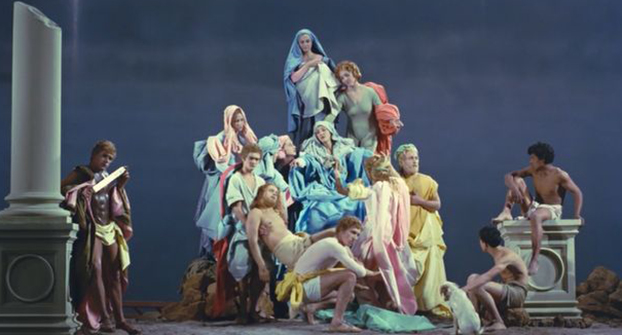
Figures 3 and 4: Rosso Fiorentino tableau vivant (top) and Pontormo tableau vivant (bottom). La ricotta (Pier Paolo Pasolini, 1963). Ro.Go.Pa.G. Eureka Entertainment, 2012. Screenshot.
Death, Editing and Tableaux Vivants
The fragmentary nature of La ricotta’s tableaux vivants is a very clear example of Pascal Bonitzer’s contention that the tableau vivant in cinema always represents a blockage in the flow of the film and can never be integrated into its narrative rhythms (31). However, for Pasolini, the stressing of the separateness of the tableau vivant is indicative of a fragmentation that exists throughout his work, for instance in the choppy editing techniques employed in his films, the incomplete and disjointed style of his several “notebook” films and his contaminazione technique in his early films. [2] It is not only in a technical sense that the fragment appeals to Pasolini, but also in the recurring motifs in his literary and filmic work of, for example, crucifixion and cannibalism, both representative of a rupture or fragmentation of the body. Such motifs also convey a fixation with death on Pasolini’s part.
Of the many paradoxes negotiated by Pasolini, as Sam Rohdie observes, was “the one that contained the contrast between life and death, reality and meaning, as poetic preconditions for each other” (98). This constant interweaving of themes relating to death, the sacred, the primitive, the subjective and the carnal with the formal qualities of film is central to Pasolini’s cinema. The notion that death consumes life corresponds to his prioritising of the primal and corporeal: our vital instincts to sleep, eat, drink, defecate, copulate, which mark us out as living beings, are extinguished in death. On a formal level, Pasolini related his ideologia della morte (ideology of death), as Lino Micciché terms it, to montage in this well-known passage from the essay “Observations on the Sequence Shot” (first published in 1967), contained in Heretical Empiricism:
It is therefore absolutely necessary to die, because so long as we live, we have no meaning, and the language of our lives (with which we express ourselves, and, to which, we therefore attribute the greatest importance) is untranslatable, a chaos of possibilities, a search for relations and meanings without resolution. Death effects an instantaneous montage of our lives; that is, it chooses the truly meaningful moments (which are no longer modifiable by other possible contrary or incoherent moments) and puts them in a sequence, transforming an infinite, unstable and uncertain—and therefore linguistically not describable—present into a clear, stable, certain and therefore easily describable past … It is only thanks to death that our life serves us to express ourselves … Editing therefore performs on the material of the film … the operation that death performs on life. (236–7; emphasis in original)
Similarly, in his essay “Is Being Natural?” (first published in 1967), Pasolini states that because the actions depicted in cinema are analogous to, and signify, events that happened in real time, their meaning is already completed:
[A]s if death had already occurred. This means that in cinema time is complete, even if only through a pretence. Therefore, one must necessarily accept the story. Time in this context is not that of life when it lives, but of life after death; as such it is real, it is not an illusion, and it can very well be that of the story of a film. (Heretical Empiricism 243)
The pictorial, the filmic image’s association with both death and the loss of the corporeal, and the sacredness that Pasolini attributes to death as the final consumer of life possess more relevance for him than any spiritual longing for resurrection, redemption or transcendence. This explains why he attributes such importance to the iconography of the Passion and, specifically, the crucifixion. Stracci’s demise at the end of La ricotta, which is representative of a tendency in Pasolini’s early films to end in death, can be understood through the prism of the desire to complete a narrative arc, in which death is viewed as a cessation of the corporeal. In this respect, it becomes evident why Pasolini saw death, in contrast to God or nature, as that which could not be demystified—its power comes from its ability to end life and, with it, all life’s physicality and passions.
Further pursuing Pasolini’s equation of death and editing, we can say that the process of editing, the literal cutting of the filmic material, followed to its logical conclusion, yields the smallest unit of film—the frame. Inherent in the ontology of the frame is stasis and the paradox of the analogue moving image, composed of a sequential series of still images. Accordingly, from Pasolini’s theory that death and editing perform the same processes of rendering the present past, one might draw the conclusion that editing to the single frame—and thereby stilling movement—can be interpreted as the embodiment of death, in a corollary to Pasolini’s suggestion that any given life could be described as an infinite sequence shot (Heretical Empiricism 236–7). In their stasis and ability to block the flow of images, the tableaux vivants in La ricotta,accentuated by the use of colour and studio setting, exemplify Pasolini’s idea of the single frame as death. Furthermore, the two images recreated in the tableaux vivants possess a sequentiality that may be read as interrupted motion, in that Rosso Fiorentino’s painting shows the moment when the Christ figure has just been released from the cross, whereas Pontormo’s painting—the reenactment of which is the second of the two tableaux vivants in the film—depicts the deposition group and the Christ figure as if they are hovering just above the ground, that is, in temporal terms, moments after Rosso Fiorentino’s image. In this way, the two reenactments might be considered, using Pasolini’s own logic, as a cinematisation of art-historical images.
Mannerism’s Abstracted Corporeality
Given Pasolini’s previous duplication of the simplicity and symmetry of Trecento and Quattrocento aesthetics in Accattone and Mamma Roma, to which the elongated artificiality and complex composition of Mannerism are almost the antithesis, it initially seems somewhat surprising that the latter forms the pictorial referent for La ricotta. However, when one considers that Mannerism came about through what might be called a crisis of form, its citation becomes more understandable. Following on from the High Renaissance, during which draughtsmanship, composition, proportion and perspective were deemed to have equalled or surpassed Greek and Roman classicism, the artists of the next generation were obliged to consider which direction they should take in the wake of these formidable artistic achievements. The term Mannerism arises from the younger artists’ imitation of the style or maniera of their predecessors while trying to exceed their achievements with increasingly complex poses and compositions. This imitation and exaggeration of High Renaissance style was an instance of art imitating art, rather than nature. Formally, this was expressed in the distortion of the ideal proportions of the human body, the highly complex poses, the garish, dreamlike colour and the disruption of the harmonious, symmetrical compositions characteristic of the High Renaissance.
Mannerism’s distancing itself from the classicism of the High Renaissance and its deliberate attempts to distort the proportions of the human body to attain a denatured corporeality resemble the conscious artificiality of Pasolini’s contaminazione technique. Pasolini identifies himself with his “brothers that are no more” in their struggle to find a new formal language through citation, as Orson Welles proclaims in La ricotta, quoting from Pasolini’s poem “Poesie mondane”. [3]
Art historian Linda Murray captures the sense of drama and delirium created by the overextended Mannerist figures in her description of Rosso Fiorentino’s Descent from the Cross, the first tableau vivant in La ricotta:
The light is not a normal illumination nor even a poetic evocation: the scene is lit as if by lightning, and in the blinding flash the figures are frozen in their attitudes and even in their thoughts, while the great limp body of the dead Christ, livid green with reddish hair and beard, dangles perilously as His dead weight almost slips from the grasp of the men straining on the ladders. (158)
Similarly, she describes the painting’s “violent and emotional expressiveness, which overrides everything else, and seeks only to provoke in the spectator a thrill of horror and grief comparable with that which shattered the men and women who helped to lift Christ from the cross and bury Him” (158), while Paoletti and Radke describe Pontormo’s Deposition as “a spasm of emotional reaction to Christ’s death” (446). In the latter painting, the note of exquisite suffering is heightened by its composition, which differs significantly from the work of the early Renaissance painters. The sculptural solidity and stillness is replaced by a delirium of movement creating a vortex with nothing at its centre but a white cloth. Surrounding this vortex, the figures portrayed overlap and touch to the extent that there is hardly any space unfilled by cloth or figure.
The Erotic Appeal of the Crucifixion
As has already been mentioned, the two deposition paintings are sufficiently similar to function as essentially sequential still frames. Likewise, the theme, the lurid colours and the ecstatic, denatured corporeal emphasis displayed by both works suggest that Pasolini operates almost interchangeably between the two paintings, particularly because the studio backdrop is unchanged and the same group of actors, including the actor who plays Christ, appear in both tableaux vivants. In relation to the latter point, it should be noted that a different actor appears as Christ opposite Stracci’s Good Thief; like Stracci, he is clean-shaven with short hair, in a self-conscious rejection, on Pasolini’s part, of typical Christological iconography. The choice of the same actor as the Christ figure in the two tableaux vivants, with a markedly different Christ in the exterior scenes, again emphasises the separate, but parallel, trajectories of the Mannerist citations and Stracci’s reality, which I discuss below.
Death, as discussed above, exerts a cathectic hold on Pasolini, in that he sees life as being defined by the boundary presented by it. However, death by crucifixion holds a specific erotic appeal for Pasolini, as evidenced in the fantasy he describes below, in which he imagines himself being crucified in the place of Christ:
In my fantasies there was expressly the desire to imitate Christ in his sacrifice for others, to be condemned to death and killed although innocent. I saw myself hanging from the cross, nailed to it. My thighs were scantily covered by a light piece of cloth and a huge crowd was looking at me. That public martyrdom became for me something voluptuous and sometimes I was nailed to the cross completely nude … With my arms spread out, my hands and feet nailed, I was utterly defenceless, lost. (“Quaderni Rossi” xx)
This eroticism is also manifested in Pasolini’s poem “La crocifissione”(“The Crucifixion”), reproduced in Michael Hardt’s translation below, in which his crucifixion fantasies and his subjective identification with Christ become clear.
All His wounds are open to the sun
And He dies under the eyes
Of everyone: even His mother
Under His breast, belly and knees,
Watches His body suffer.
Dawn and dusk cast light
on His open arms and April
softens His exhibition of death
to gazes that burn Him.Why was Christ EXPOSED on the cross?
Oh, the heart shudders at the naked
Body of the youth … atrocious
Offence to its raw modesty …
The sun and the gazes! The ultimate voice asked God forgiveness
With a sob of red shame
In a sky without sound,
Between His fresh and weary
Pupils; death, sex and pillory.
You must expose yourself (is this what the
Poor nailed-up Christ teaches?),
The clarity of the heart is worthy
Of every sneer, every sin
Every more naked passion …
(is this what the Crucifix means?
Sacrifice every day the gift
Renounce every day forgiveness
Cast yourself ingenuous over the abyss).We will be offered on the cross,
On the pillory, between the pupils
Limpid with ferocious joy,
Leaving open to irony the drops of blood from the breast to the knees,
Gentle and ridiculous, trembling
With intellect and passion in the play
Of the heart burning from its fire,
Testifying to the scandal. (Hardt 77–8)In his analysis of the poem, Michael Hardt deals comprehensively with how the transcendental form of the Christ figure is emptied into the material; this “self-emptying” or kenosis yields a state in which essence and existence are simultaneously contained in the flesh. The Christ figure is typically viewed as a mediator of the external relationship between divine essence and worldly existence; however, Hardt contends that the incarnation or self-emptying of Christ disallows any exteriority and hence the need for mediation:
Any imagined transcendent substance, separated from the world, is merely a hollow husk, a form emptied of all being … Transcendence, the condition of possibility of being, should not be imagined as above or below the material—it dwells, rather, precisely at its very surface. Incarnation is the claim that there is no opposition and no mediation necessary between the transcendent and the immanent, but an intimate complementarity. This immanent transcendence is the innermost exteriority of being, the potentiality of the flesh. (581–2)
The conjoining of the immanent and transcendent in the flesh of Christ is fundamental to the affinity Pasolini feels for the Christ figure, particularly in its crucified and deposed form. Hardt observes that, rather than the formality of incarnation at birth, the real incarnation of Christ occurs on the cross, where Christ is “abandoned to the divinity of the flesh” (79). This exposure of the flesh holds an erotic charge for Pasolini, which in its very morbidity is life-affirming (“offered on the cross … pupils limpid with ferocious joy”). Two observations should be made here: firstly, in contrast to the conventional Christological figure, Pasolini’s Christ is erotically cathected, which correlates to a similar eroticism that pervades the Mannerist renditions of the deposition; [4] secondly, in contrast to the descent of the divine to be incarnated into the human, as Hardt describes and as imagined in subjective terms by Pasolini in “La crocifissione”, the notion of an evacuation of the divine into the corporeal is rejected in La ricotta. Rather, in its very materiality and profanity, as represented by Stracci, the body is already divine, being rendered transcendent through its immanence.
The notion of an immanence within which transcendence is already contained is described in Jean-Luc Nancy’s term transimmanence. Nancy uses this term in relation to art being: “the transcendence of an immanence that does not go outside itself in transcending” (35). Transimmanence rejects the polarities of the transcendent as external and the immanent as internal, instead locating both within the realm of human experience and sense. As Mark Lewis Taylor argues, Nancy’s concept is in a dialectical relationship with transcendence (126), rather than Deleuze and Guattari’s concept of pure or absolute immanence, or an “immanence [that] is immanent only to itself and consequently captures everything … and leaves nothing remaining to which it could be immanent” (45). The acknowledgement of the presence of a transcendent element within the immanent seems to best encapsulate Pasolini’s veneration of Stracci. For Pasolini, the sacred is permanently resident in the latter’s raw corporeality, rather than temporarily dwelling or being “self-emptied” into a Christological body. In the second part of the article, I examine how, by presenting the body of Stracci as both carnivalesque and cinematic, Pasolini deposes the conventional divine body and its artistic representation to elevate in its place Stracci’s prosaic materiality.
Stracci’s Profane Corporeality
In La ricotta, the immanent in the form of multiple registers of life complements the double register of death that exists through the reenacted depositions and Stracci’s demise. In this respect, Stracci represents the most primal and vital human instincts. He eats, he sleeps, he has fathered a clutch of children and throughout the film is depicted bare-chested in his loincloth costume, worn with only a sports jacket and shoes. Although his corporeality appears to be the converse of the “divine exposure of the flesh” that is identified in Christ’s body (Hardt 82), Pasolini’s achievement in La ricotta is to juxtapose the divine immanence of Christ and the eroticism associated with exposure, as mediated by the Mannerists’ deposition paintings, with Stracci’s far more mundane corporeality.
The relationship between the corporeal primitive, as represented by Stracci, and the corporeal divine, as represented by the deposition paintings, finds a historical antecedent in the gradual shift from the pagan nature of the carnival to the religious Passion Play in the Middle Ages. Mikhail Bakhtin defines what he terms the carnivalesque as a force of opposition to a dominant worldview, one that celebrates “temporary liberation from the prevailing truth and from established order” (10). He identifies the carnivalesque as the combination of the sacred with the profane and the high with the low and as relating to the permeation of the boundary between the self and world. This boundary takes the form of bodily orifices. Functions that involve a crossing of this boundary such as eating, drinking, excretion and sexual activity serve to detract from the sacred and abstract by reinscribing them in the real or corporeal world. Bakhtin views scenes of eating and drinking in a social context as fundamental to the carnivalesque. He specifically interprets the banquet as being representative of the celebration of a triumph over social mores and hierarchy that freely blends the sacred and the profane, high and low culture, and the spiritual and the material.
While the carnivalesque in La ricotta is manifested through elements such as the communal laughing and joking of the film crew, Stracci dressing in women’s clothes to steal a second lunch and a female extra performing a striptease to frustrate him while he is tied to the cross on the ground, the parallel between the sacred and the carnivalesque is particularly evident in the form of the banquet in the film. A recurrent motif is the trestle table laden with food, reminiscent of a Dutch seventeenth-century still-life painting. Although no specific memento mori is present, as is conventional in such paintings, the array of ripe fruit may be read as a subtle vanitas, indicating the transience of life. [5] Moreover, at one point in the film, Stracci indulges in his own subterranean banquet without table, cloth or utensils, but consuming the same prodigious amount of food as is displayed on the more formal table. Both versions of the banquet depicted in the film can be viewed as reflections of one of the focal points of the film: Stracci’s excessive, gargantuan appetite. [6] In his parodic version of the Last Supper, Stracci finally succeeds in satiating his hunger. While doing so, he is surrounded by the actors and film crew who throw food to him from the banquet table, reflecting the chaos and disorder of the carnivalesque.
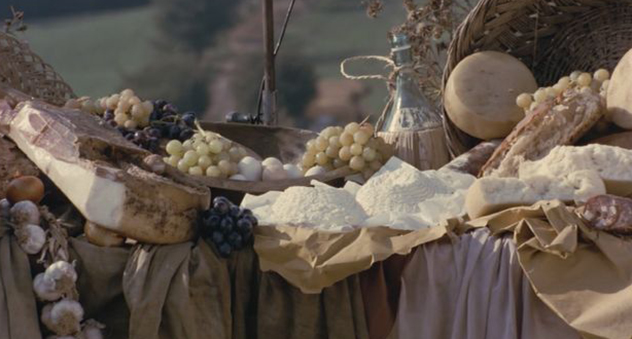
Figure 5: Banqueting table. La ricotta. Eureka Entertainment, 2012. Screenshot.
Stracci plays the role of the fool and the jester, which Bakhtin identifies as being central to the carnivalesque, particularly in relation to the grotesque body (22). Pasolini foregrounds this role by stylistically linking Stracci to the figure of Charlie Chaplin’s Little Tramp in various ways. In the opening scene, the viewer’s first sight of Stracci is as he wakes up on the ground and then gets kicked in the seat of his pants by one of the film crew, recalling staple comic tropes in Chaplin’s films. His competition with the star’s dog for food is similar to the parallels drawn between the Little Tramp’s existence and that of his dog Scraps in A Dog’s Life (1918). The music that accompanies Stracci’s long walk to purchase the ricotta mimics that of silent film, while the deliberate changes of speed in the film during his journey and his underground meal exaggerate his movements, seemingly imitating the mechanised choreography of Chaplin’s bodily humour. The long walk itself can be seen as a combination of Christ’s Via Crucis and the vagabond mobilities of Chaplin, which often form an inherent part of his films’ narratives. [7] Equally inherent in the presentation of The Little Tramp is a pointed social commentary on the conditions of the marginalised in society at the time, which is also the case in Pasolini’s early Roman films, including La ricotta. [8]
Figure 6 (left): Chaplin on the road in The Tramp (1915). Sunflower Pictures, 2008. Screenshot.
Figure 7 (right): Chaplin asleep on the ground in A Dog’s Life (1918). Delta, 2002. Screenshot.
Figures 8 and 9: Stracci in Chaplinesque mode. La ricotta. Eureka Entertainment, 2012. Screenshots.
By purposely representing him in Chaplinesque style, Pasolini seeks to isolate Stracci from the art-historical excesses he hopes to exorcise in the making of La ricotta. However, while Stracci’s alignment to the cinematic may be considered to remove him from the art-historical citation in the film, the stylistic parallels between Mannerism and early cinema via Chaplin should also be remarked. Just as Mannerism highlights the corporeal through its overemphasis on particular body traits, such as contorted facial expression and long, swanlike necks, the coded citation of silent film points to a similar exaggerated plasticity in cinematic form, emphasised by the change in film speed and lack of dialogue in the Chaplinesque sequences. Through the respective citation of highly stylised examples of artistic and filmic form, Pasolini creates a rapprochement between these two strands, one representing the abstract and divine and the other—in the form of Stracci—the corporeal and carnivalesque.
Ascending and Descending Vectors
Pasolini’s deposition of the iconographical Christ figure in deference to Stracci’s transimmanence is also reflected in a devaluation of the significance of the structure of the cross, which only fully comes into view in the final scene. Indeed, in Pontormo’s original painting and in its reenactment in La ricotta, the cross is wholly absent, while in the original and reenactment of Rosso Fiorentino’s deposition, the cross is so covered with the bodies of the deposition group as to be barely visible. This lack of a supporting structure in the deposition scene, with the exception of the other human figures that attempt to keep Christ’s body raised above the ground, prioritises a descendant vector, which may be interpreted as representing the deposition of the divine and the art historical. In this regard, it should be noted that, while the deposition refers to the physical descent of Christ’s body from the cross, a synonym for deposition is deconsecration. Thus the concept of desacralising is inherent in the act of deposition.
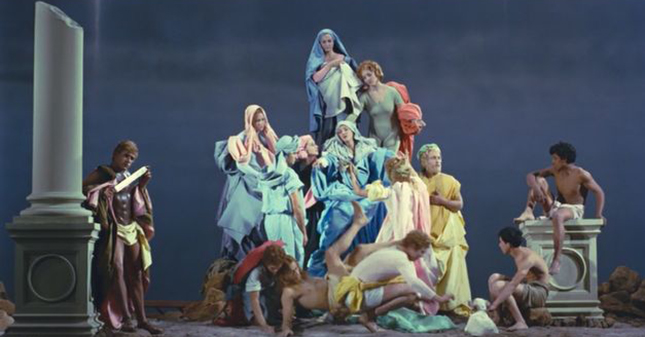
Figure 10: Collapse of the Pontormo tableau vivant. La ricotta. Eureka Entertainment, 2012. Screenshot.
In Pontormo’s original painting, the group of figures seem to levitate just above the ground, without the completion of the act of deposition or the downward movement. This stresses the sense of a physically impossible corporeality. As Paoletti and Radke observe, it is unlikely that the “balletically positioned” kneeling male figure, who is balancing on his toes, would be able to support a dead body (446). In contrast, the reenactment tends to foreground the gravity and downward motion at play; the earth’s gravitational pull inevitably triumphs. The actors, to their great amusement, cannot sustain the weight of Christ’s dead body and fall in a combined heap on the ground. Thus, by reenacting the painting—literally embodying it—the actors tend away from the abstracted corporeality of Pontormo’s original towards the physical, comic and cinematic corporeality of Stracci, with its inherent emphasis on the earthbound and immanent.
The collapse of the tableau vivant, or a similar disintegration,seems inevitable throughout the film. Constantly exhorted by the assistant director to maintain their static poses, the actors tend towards movement and laughter, and hence the carnivalesque, evidenced, for instance, by the elderly man in the Rosso reenactment picking his nose or the dance music that is mistakenly played over the first tableau vivant scene rather than the required classical score by Scarlatti. This tendency towards disorder dissociates the actors from the abstracted corporeality of the paintings and deposes them—or desacralises them, like the Christ figure.
In the film, as we have seen, the collective movement of the tableau vivant actors is a gradual downwards motion from their original elevated positions in the first deposition reenactment to the collapse of the second one. In contrast, Stracci is presented throughout the film as being almost physically attached to the earth. Variations of the first shot of the ill-fated extra lying on the ground recur in the film; particularly when he is tied to the cross waiting for his scene to be filmed. At one point, he comments to the actor playing Christ, who lies on a cross beside him, that he would take the “Kingdom of Earth” rather than the “Kingdom of God”, highlighting the sense of earthbounded-ness associated with him.
During the “Last Supper” scene, in addition to images of Stracci on the ground, he is also seen underground, in the small subterranean cave near the film set, stressing the corporeality at play through his body being contained within the body of the earth. The physical connection with the ground is again emphasised in this scene by Stracci sitting on a mound of earth and consuming the food so ravenously that it covers his mouth and hands and drops onto his body. As stated previously, the actors from the tableaux vivants are physically placed in opposition to Stracci, but have also been shifted further downwards since succumbing to the gravity that Pontormo’s painting ignores. Now relocated from the abstract studio setting and reformed into a spontaneous, informal composition underground, within which laughter and movement are possible, they are also returned to the earthbound and the carnivalesque, towards which their problematic embodiment of the Mannerist paintings tended consistently. The rapture and piety that the director struggled to elicit have evaporated and are replaced, as in the failed tableau vivant, by joking and merriment, realigning the actors to Stracci, and, consequently, to the comedy of Chaplin and Bakhtin’s carnivalesque.

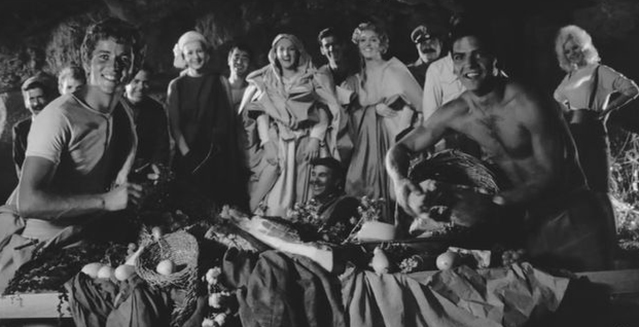
Figures 11 and 12: Stracci underground, and the tableaux vivant actors reformed underground. La ricotta. Eureka Entertainment, 2012. Screenshot.
Finally, in the closing scene of the film, in an exchange of position with the art-historical, iconographical Christ figure, who has been displaced from the cross, Stracci is raised aloft, with the cruciform structure returning to its iconographical position. Thus the reversal is complete: the Christ figure is deposed and substituted by Stracci, who, suffering from the effects of consuming such a vast amount of food, dies on the cross. Deposed alongside the Christological are Pasolini’s excessive art-historical tendencies and the erotic cathexis of the crucifixion, with the concomitant elevation of the corporeal, the comic and carnivalesque, all representative of immanence and earth-dwelling.
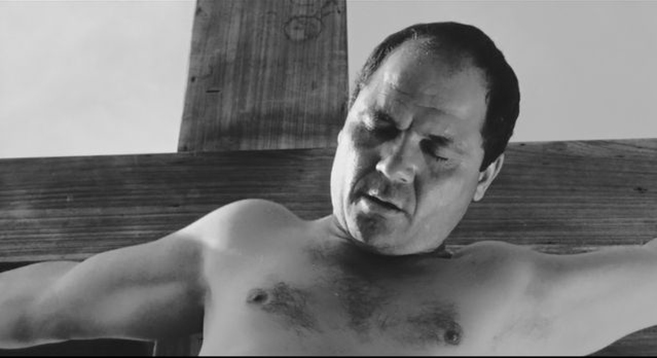
Figure 13: Stracci dies on the cross. La ricotta. Eureka Entertainment, 2012. Screenshot.
Conclusion
In conclusion, the fragmentation inherent in La ricotta is overcome by the drawing together and eventual reversal of the Mannerist depositions and Stracci’s reality, as mediated through the physical reenactment of the paintings. With the juxtaposition of Mannerism and Stracci’s corporeal mimicking of silent cinema, particularly the work of Chaplin, Pasolini highlights the tension between movement and stasis inherent in La ricotta,but also establishes another duality between the ability of painting and film to present a true register of the sacred. In the film, the art-historical is associated with an abstracted transcendent divine, an impossible corporeal and a libidinal compulsion towards the notion of crucifixion. In contrast, the cinematic is related to a transimmanent sacred firmly located within the carnivalesque, in the form of the comic and corporeal reality of Stracci, whose bodily desires, while excessive, are uncomplicated, earthly and honest, rooted in an uncoded corporeal instinct. For Pasolini, this is truly worthy of veneration, thus he confers on it an ultimate meaning through Stracci’s death on the cross.
Notes
[1] La ricotta formed part of a compendium of short films entitled Ro.Go.Pa.G., so titled after the surnames of the directors involved: Roberto Rossellini, Jean-Luc Godard, Pier Paolo Pasolini and Ugo Gregoretti.
[2] Contaminazione (contamination) refers to Pasolini’s blended use of high and low cultural elements in his filmmaking. A well-known example is the use of Bach’s St Matthew’s Passion for the soundtrack of his first film Accattone, whose eponymous protagonist is a pimp living in the Roman borgate.
[3] In this respect, it is interesting to note Steven Jacob’s contention that Pasolini’s struggle with the heritage of neorealism equates with the Mannerists’ similar challenge in relation to classical Renaissance models (102).
[4] See Rebecca Zorach on the erotic attraction of the crucifixion theme for the Mannerist painters (79–80).
[5] Traditionally, the vanitas was a still life that contained some form of memento morisuch as a skull or an egg timer to indicate death and transience, generally. However, more subtle examples of a vanitas were still lifes depicting ripe fruit, spilt wine or withering flowers. In the banquet table in La ricotta we see fruit overturned out of a basket and ripe cheeses.
[6] See Fabio Vighi on the subject of appetite, jouissance and the subproletariat in La ricotta (76–8).
[7] See Tim Cresswell on Chaplin, mobility and the figure of the tramp (151–9).
[8] Chaplin was much admired by Pasolini. He is also referenced in Che cosa sono le nuvole (1968) by means of a framed photograph found in Totò’s chaotic house. This is one of the only objects that Totò’s new wife retains when she restores the house to order. In addition in “The Cook’s Tale” episode of The Canterbury Tales (1972), Ninetto Davoli plays the central character, Perkin Reveller, as a Chaplinesque character complete with bowler hat, baggy suit and cane, and with a minimal amount of dialogue.
References
1. Bakhtin, Mikhail M. Rabelais and his World. Bloomington: Indiana U.P., 1984. Print.
2. Bertolucci, Bernardo, and Jean-Louis Comolli. Entretien avec Pasolini. In “Pasolini Cinéaste”. Hors-Série, Cahiers du Cinéma. Ed. Alain Bergala and Jean Narboni. Paris: Éditions de l’Étoile, 1981. 35–42. Print.
3. Bonitzer, Pascal. Décadrages. Paris: Éditions de l’Étoile, 1985. Print.
4. Chaplin, Charles, dir. A Dog’s Life. 1918. Delta, 2002. DVD.
5. ---, dir. The Tramp. 1915. Sunflower Pictures, 2008. DVD.
6. Cresswell, Tim. The Tramp in America. London: Reaktion Books, 2001. Print.
7. Deleuze, Gilles, and Félix Guattari. What is Philosophy? London: Verso, 1994. Print.
8. Hardt, Michael. “Exposure: Pasolini in the Flesh”. A Shock to Thought: Expression After Deleuze and Guattari. Ed. Brian Massumi. London: Routledge, 2001. 77–84. Print.
9. Jacobs, Steven. Framing Pictures: Film and the Visual Arts. Edinburgh: Edinburgh U.P., 2011. Print.10. Lessing, Gotthold Ephraim. Laocoön: An Essay on the Limits of Painting and Poetry. Trans. Edward Allen McCormick. Baltimore: John Hopkins U.P., 1989. Print.
11. Lewis Taylor, Mark. The Theological and the Political. Minneapolis: Fortress Press, 2011. Print.
12. Micciché, Lino. “L'ideologia della morte nell'ultimo Pasolini”. Storia del cinema. 3. Autori e tendenze negli anni cinquanta e sessanta, Ed. Adelio Ferrero. Venice: Marsilio, 1978. Print.
13. Murray, Linda. The High Renaissance and Mannerism. London: Thames and Hudson, 2003. Print.
14. Nancy, Jean-Luc. Muses. Stanford: Stanford U.P., 1996. Print.
15. Paoletti, John T. and Gary Radke. Art in Renaissance Italy. London: Laurence King Publishing, 2005. Print.
16. Parant, Céline. De Giotto à Caravage: la troisième dimension picturale dans quelques films de Pasolini. 2005. Web. 21 Feb. 2014. <http://www.pasolini.net/celine_presentazione.htm>.
17. Pasolini, Pier Paolo, dir. Accattone. Arco Film, 1961. Film.
18. ---. Alí dagli occhi azurri. Milan: Garzanti, 1965. Print.
19. ---, dir. Che cosa sono le nuvole. Dino de Laurentiis Cinematografica, 1968. Film.
20. ---. Heretical Empiricism. Washington: New Academia Publishing, 2005. Print.
21. ---, dir. La ricotta. Episode of Ro.Go.Pa.G. Dir. Roberto Rossellini, Jean-Luc Godard, Pier Paolo Pasolini, and Ugo Gregoretti.1963. Eureka Entertainment, 2012. DVD.
22. ---, dir. Location Hunting in Palestine [Sopralluoghi in Palestina per Il Vangelo secondo Matteo]. Arco Film, 1963. Film.
23. ---, dir. Mamma Roma. Arco Film, 1962. Film.
24. ---. Mamma Roma. Milano: Rizzoli, 1962. Print.
25. ---, dir. Pigsty [Porcile]. I Film Dell’Orso, 1969. Film.
26. ---. Poesie mondane, in Poesia in forma di rosa. Milan: Garzanti, 1964. 15–24. Print.
27. ---. “Quaderni rossi del 1946”. Lettere, vol. I (1940–1954). Ed. Nico Naldini. Turin: Einaudi, 1986. Print.
28. ---, dir. Salò, or the 120 days of Sodom [Salò, o le 120 giornate di Sodoma]. Produzioni Europee Associati, 1975. Film.
29. ---, dir. The Canterbury Tales [I racconti di Canterbury]. Les Productions Artistes Associés, 1972. Film.
30. ---, dir. The Gospel According to St Matthew [Il Vangelo secondo Matteo]. Arco Film, 1964. Film.31. Pontormo, Jacopo. Deposition. 1523–25. Oil. Santa Felicita, Cappella Capponi. Florence.
32. Rhodes, John David. Stupendous, Miserable City: Pasolini’s Rome. Minneapolis: U. of Minnesota P., 2007. Print.
33. Rohdie, Sam. The Passion of Pier Paolo Pasolini. Bloomington and Indianapolis: Indiana U.P., 1995. Print.
34. Rosso Fiorentino. Deposition (1521). Oil on wood. Pinacoteca,Volterra.
35. St Matthew’s Passion. J.S. Bach (comp.). Accattone. Dir. Pier Paolo Pasolini. Medusa Video, 2009. DVD.
36. Viano, Maurizio. A Certain Realism. Berkley: U. of California P., 1993. Print.
37. Vighi, Fabio. Traumatic Encounters in Italian Film: Locating the Cinematic Unconscious. Bristol and Portland, Oregon: Intellect, 2006. Print.
Suggested Citation
Murphy, J.(2014) 'Dark fragments: contrasting corporealities in Pasolini's La ricotta', Alphaville: Journal of Film and Screen Media, 7, pp. 39–56. https://doi.org/10.33178/alpha.7.03.
Jill Murphy works as an assistant lecturer and postdoctoral researcher in Film and Screen Media at University College Cork. She completed her PhD in Film Studies at University College Cork in 2012 with a thesis titled “Hoc est enim corpus meum: Christian Art and Passion Iconography in the Work of Pier Paolo Pasolini and Jean-Luc Godard”. Her research interests focus on the relationship between film and art history, particularly as regards human figuration, and the work of Jean-Luc Nancy on the body and its representation in visual media.






